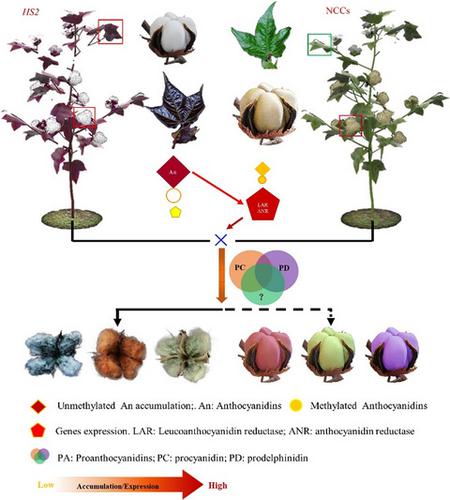当前位置:
X-MOL 学术
›
Plant Biotech. J.
›
论文详情
Our official English website, www.x-mol.net, welcomes your feedback! (Note: you will need to create a separate account there.)
Function deficiency of GhOMT1 causes anthocyanidins over-accumulation and diversifies fibre colours in cotton (Gossypium hirsutum)
Plant Biotechnology Journal ( IF 13.8 ) Pub Date : 2022-05-03 , DOI: 10.1111/pbi.13832 Liping Ke 1 , Dongliang Yu 1 , Hongli Zheng 1 , Yihan Xu 1 , Yuqing Wu 1 , Junye Jiao 1 , Xiaoli Wang 1 , Jun Mei 1 , Fangfang Cai 1 , Yanyan Zhao 1 , Jie Sun 2 , Xianlong Zhang 3 , Yuqiang Sun 1
Plant Biotechnology Journal ( IF 13.8 ) Pub Date : 2022-05-03 , DOI: 10.1111/pbi.13832 Liping Ke 1 , Dongliang Yu 1 , Hongli Zheng 1 , Yihan Xu 1 , Yuqing Wu 1 , Junye Jiao 1 , Xiaoli Wang 1 , Jun Mei 1 , Fangfang Cai 1 , Yanyan Zhao 1 , Jie Sun 2 , Xianlong Zhang 3 , Yuqiang Sun 1
Affiliation

|
Naturally coloured cotton (NCC) fibres need little or no dyeing process in textile industry to low-carbon emission and are environment-friendly. Proanthocyanidins (PAs) and their derivatives were considered as the main components causing fibre coloration and made NCCs very popular and healthy, but the monotonous fibre colours greatly limit the wide application of NCCs. Here a G. hirsutum empurpled mutant (HS2) caused by T-DNA insertion is found to enhance the anthocyanidins biosynthesis and accumulate anthocyanidins in the whole plant. HPLC and LC/MS-ESI analysis confirmed the anthocyanidins methylation and peonidin, petunidin and malvidin formation are blocked. The deficiency of GhOMT1 in HS2 was associated with the activation of the anthocyanidin biosynthesis and the altered components of anthocyanidins. The transcripts of key genes in anthocyanidin biosynthesis pathway are significantly up-regulated in HS2, while transcripts of the genes for transport and decoration were at similar levels as in WT. To investigate the potential mechanism of GhOMT1 deficiency in cotton fibre coloration, HS2 mutant was crossed with NCCs. Surprisingly, offsprings of HS2 and NCCs enhanced PAs biosynthesis and increased PAs levels in their fibres from the accumulated anthocyanidins through up-regulated GhANR and GhLAR. As expected, multiple novel lines with improved fibre colours including orange red and navy blue were produced in their generations. Based on this work, a new strategy for breeding diversified NCCs was brought out by promoting PA biosynthesis. This work will help shed light on mechanisms of PA biosynthesis and bring out potential molecular breeding strategy to increase PA levels in NCCs.
中文翻译:

GhOMT1 的功能缺陷导致花青素过度积累并使棉花(陆地棉)中的纤维颜色多样化
天然彩色棉 (NCC) 纤维在纺织工业中需要很少或不需要染色过程以实现低碳排放并且对环境友好。原花青素(PAs)及其衍生物被认为是导致纤维着色的主要成分,使NCCs非常受欢迎和健康,但单调的纤维颜色极大地限制了NCCs的广泛应用。此处发现由 T-DNA 插入引起的陆地棉紫化突变体 ( HS2 ) 可增强花青素的生物合成并在整株植物中积累花青素。HPLC 和 LC/MS-ESI 分析证实花青素甲基化和牡丹素、矮牵牛素和锦葵素的形成被阻断。HS2中GhOMT1的缺乏与花青素生物合成的激活和花青素成分的改变有关。花青素生物合成途径中关键基因的转录本在HS2中显着上调,而运输和装饰基因的转录本与 WT 处于相似水平。为了研究棉纤维着色中GhOMT1缺陷的潜在机制,将HS2突变体与 NCC 杂交。令人惊讶的是,HS2和 NCC 的后代通过上调GhANR和GhLAR增强了 PA 的生物合成,并增加了来自积累的花青素的纤维中的 PA 水平. 正如预期的那样,在他们的几代人中生产了多条改进纤维颜色的新系列,包括橙红色和海军蓝色。基于这项工作,提出了一种通过促进 PA 生物合成来培育多样化 NCC 的新策略。这项工作将有助于阐明 PA 生物合成的机制,并提出潜在的分子育种策略以提高 NCC 中的 PA 水平。
更新日期:2022-05-03
中文翻译:

GhOMT1 的功能缺陷导致花青素过度积累并使棉花(陆地棉)中的纤维颜色多样化
天然彩色棉 (NCC) 纤维在纺织工业中需要很少或不需要染色过程以实现低碳排放并且对环境友好。原花青素(PAs)及其衍生物被认为是导致纤维着色的主要成分,使NCCs非常受欢迎和健康,但单调的纤维颜色极大地限制了NCCs的广泛应用。此处发现由 T-DNA 插入引起的陆地棉紫化突变体 ( HS2 ) 可增强花青素的生物合成并在整株植物中积累花青素。HPLC 和 LC/MS-ESI 分析证实花青素甲基化和牡丹素、矮牵牛素和锦葵素的形成被阻断。HS2中GhOMT1的缺乏与花青素生物合成的激活和花青素成分的改变有关。花青素生物合成途径中关键基因的转录本在HS2中显着上调,而运输和装饰基因的转录本与 WT 处于相似水平。为了研究棉纤维着色中GhOMT1缺陷的潜在机制,将HS2突变体与 NCC 杂交。令人惊讶的是,HS2和 NCC 的后代通过上调GhANR和GhLAR增强了 PA 的生物合成,并增加了来自积累的花青素的纤维中的 PA 水平. 正如预期的那样,在他们的几代人中生产了多条改进纤维颜色的新系列,包括橙红色和海军蓝色。基于这项工作,提出了一种通过促进 PA 生物合成来培育多样化 NCC 的新策略。这项工作将有助于阐明 PA 生物合成的机制,并提出潜在的分子育种策略以提高 NCC 中的 PA 水平。


























 京公网安备 11010802027423号
京公网安备 11010802027423号